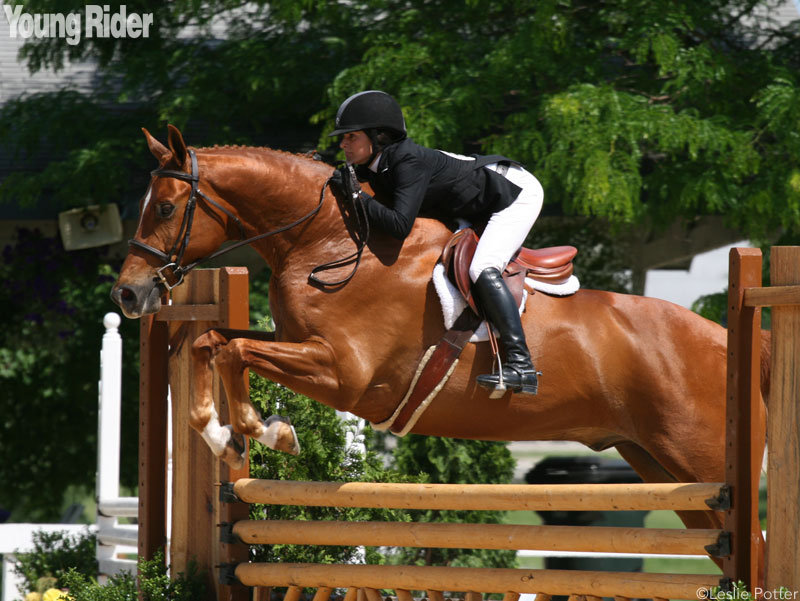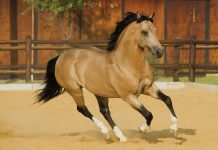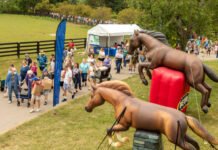
1. Always shorten your stirrups a hole or two before jumping. This lets you bring your body weight forward so you can stay over your horse’s center of balance throughout the jump.
2. Always look straight ahead over the fence. If you look down you can affect your horse’s balance and he might not jump very well.
3. Remember to push your hands forward when going over a fence. Rest your hands about 8 to 10 inches in front of the saddle and rest your hands on your horse’s neck. Doing this makes the reins looser and you won’t jab your horse in the mouth if you get left behind the motion.
4. Use a neck strap if it’s hard to stay balanced while jumping. Fasten a stirrup leather around your horse’s neck like a collar and hang on to it to stop yourself from bouncing around.
5. If your horse tends to run out of a fence on one side, carry a whip on that side and tap him with it on his neck as you approach the fence. Put lots of pressure on that side with your lower leg so he doesn’t run out.
6. Try to be confident and calm while approaching a fence. A horse can tell if you are scared. If he thinks you are too frightened to jump a fence, he probably won’t want to jump it either.
7. Don’t duck! Ducking is when a rider leans to one side when jumping. This is a bad habit and can make your horse jump badly. Have your instructor or a pal yell at you to stay straight when you approach a fence until you remember to do it yourself.
8. Let the fence come to you instead of trying to anticipate your horse’s takeoff point. Don’t lean too far forward and leap over the fence before your horse does. Push your heels down, set your legs next to the girth and keep your bottom close to the saddle. Get into jumping position a stride or two away from the fence.
9. If your horse is refusing (stopping) a lot, go back to popping over trotting poles and tiny fences for a while. When he is jumping little fences with no problems you can go back to jumping bigger ones.
10. If your horse refuses a fence, don’t beat him. Give him a sharp smack with the whip behind your leg, quickly trot a small circle and point him at the fence again. Be more aggressive and really “kick on” as you approach the fence a second time.
11. Always aim for the middle of the fence. This gives your horse less chance to run out.
12. When you are jumping a single fence, alternate the direction you go after you jump. Turn left after one jump and then right the next time. This stops your horse getting bored.
13. After jumping a fence, don’t let your pony slow down and stop right away. Keep him trotting or cantering actively until you are well away from the jump. If you let him stop every time, he’ll get lazy and refuse to move on after jumping a fence.
14. Even when you’re not jumping, practice jumping position for five minutes at a time. Riding in forward position strengthens your legs and makes you a better jumper.
15. Set up a grid. Place three crosspole jumps about 12 feet apart. Get into forward position in front of the first fence and stay in it through the grids. Horses seem to like grids and you can concentrate on your position while your horse zips through the jumps.
16. Always warm up your horse properly.Spend at least 15 minutes walking, trotting and cantering before you pop over any fences. Your horse may not feel like jumping if he’s not warmed up.
17. Don’t jump the same fence 100 times. Your horse will get bored and he might refuse. If you have only a couple of jumps in your field, move them around and liven them up by putting tires, flowers or buckets around them.
18. If you think your horse is going to spook at a scary jump, ride several 20-meter circles in front of it, so he passes by the jump every time he comes round the circle. After circling three times head toward the fence and pop over it.
19. Never walk your horse up to a fence and stop him so he can take a look at it. Stopping in front of a fence teaches your horse to refuse. It is better to ride in a circle next to the fence.
20. While jumping a course, look for the next jump in the course as you land after a fence. Looking at the next fence will help you to approach it properly.





